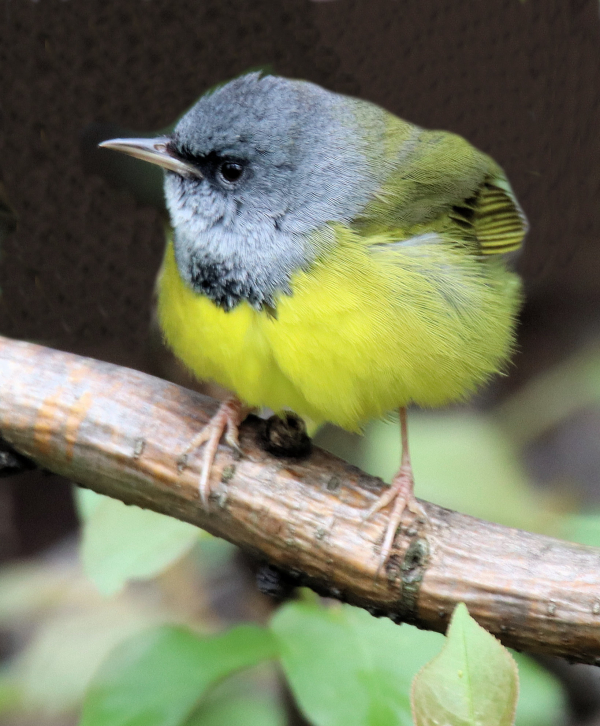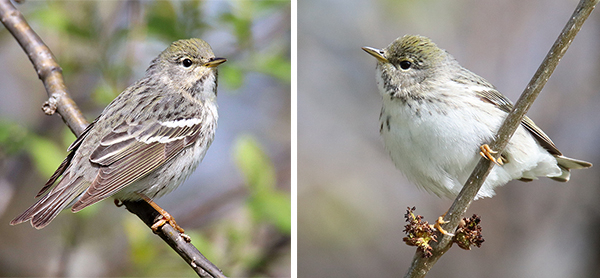
The prize of the week was a quick snapshot of a wary Mourning Warbler that perched just a moment a foot above ground at the edge of a dark tangle of plants. The low light at that location provided only a 1/250 shutter speed, even when using an f6 aperture with an ISO of 800, yet the image of the tiny bird is sharp and the color is accurate.
|
Every birder should have at least one local “migrant trap” to observe, monitor, and photograph neotropic songbirds as they stopover during select days of May. For me it’s Melody’s Grove. Each year I await the arrival of migrating songbirds – primarily species of warblers, orioles, vireos, and thrushes. Melody’s migrant trap is attractive to migrating songbirds for its habitat and location. To the south are more than 40 miles of open prairie and farmland, so the finger of trees that leads to a half-square-mile of open woods is a welcome sight to small, tired, hungry, thirsty birds. Many stop at the very first tree and work their way through the thick growth of trees, bushes, and grasses, although there are open areas too, especially along the edges of the grove and in the tree tops.
Melody grew up there; it was her family’s farm, which was located across the road from my grandparent’s house and their Standard gas station – just 200 yards southeast of my present day house. I remember Melody when she was a teenager, an especially nice girl who would stop by my grandparent’s yard when my family visited from Bismarck. Today Melody lives a thousand miles away, but the farmyard and trees and bushes remain untouched, overgrown; but beautiful in the eyes of birds and this birder.
For me, this annual spring migrant stopover hotspot provides some of the most enjoyable hours and days of photography each year, partly because you never know what to expect as far as species and numbers of birds present. But over time, it’s become somewhat predictable in that there are usually 3 waves of migrants that utilize Melody’s Grove for a few hours or a few days each spring, which I break up into the early, middle, and late waves. Each wave tends to be more exciting as the season progresses, building toward June first, when frankly, there is a disappointing but expected end to the excitement and fun of songbird migration.

The “early wave” passes through during the second week of May, dominated by Yellow-rumped Warblers with a few male Yellow Warblers and Black-and-White Warblers mixed in. There are also a few Northern Waterthrushes, Ovenbirds, Hermit Thrushes, Brown Thrashers, and Least Flycatchers.
The “middle wave” is dominated by Yellow Warblers with many Tennessee Warblers, some Yellow-rumped Warblers, many Baltimore and Orchard Orioles, Least Flycatchers, Gray Catbirds, Swainson’s Thrushes, plus a few American Redstarts, Blackpoll Warblers, Black-and-White Warblers, Rose-breasted Grosbeaks, Ruby-throated Hummingbirds, and Warbling Vireos.
The “late wave” includes the rarer birds and some of the most exciting species, including Magnolia Warblers, Mourning Warblers, Blackpoll Warblers, continuing Yellow Warblers, American Redstarts, Red-eyed Vireos, and orioles, plus the potential for some eastern warblers some years, such as Canada Warblers, Northern Parulas, Bay-breasted Warblers, Blackburnian Warblers, Nashville Warblers, Chestnut-sided Warblers, Cape May Warblers, Yellow-breasted Chats, maybe a bunting (Lazuli or Indigo), maybe a Scarlet Tanager, a Great Crested Flycatcher; who knows? And that’s part of the excitement and fun!
Within each wave of birds, there are normally a few “migrant fallouts” when many birds made up of a variety of species arrive after an overnight migration that may extend into the morning hours. They may remain through the morning, sometimes into the afternoon, and sometimes for an additional day or so – it’s unpredictable. But I watch weather reports to monitor wind direction and other migration variables, and the past couple years I’ve been checking the BirdCast website for migration forecasts in my area, along with the real-time migration radar views for the Lower 48 States – sometimes the night before and sometimes after the fact to better understand what I was experiencing on a given day in May.
Even so, each May songbird migration is different, unpredictable, and that’s an exciting part of birding. Species composition and abundance during migration in this area is especially unpredictable because southeast North Dakota is located at the western edge, or beyond the western edge, of the migration range of many species that primarily migrate farther east – from the Mississippi River east to the Atlantic Coast. But Melody’s Grove proves to be a very special place, a spring migrant trap, or maybe it’s better described as a spring migrant oasis, where exciting birds can be found the latter 3 weeks of May.

Photographing at Melody’s
When I first noticed warblers and other songbirds at Melody’s Grove, I photographed on foot, walking along the edge of the Grove, watching, stopping, waiting, and continuing – photographing when possible. That method was an excellent way of observing and photographing there, but I soon found I had much better success photographing when I became mostly invisible, when using my “mobile photo blind” at the Grove – my vehicle. I’ve used a Lincoln, a Cadillac, a PT Cruiser, and a series of vans to photograph birds from. It doesn’t matter what model it is, although some vehicles provide a little higher profile, which is usually an improvement for observing birds among the vegetation and while photographing.
Using a vehicle as a mobile blind allows you the mobility to easily move a few feet, a hundred feet, or a quarter-mile as needed, or as you wish – forward, backward, or to either side. You are essentially hidden, which is a plus for any wildlife photography; animals often tend to ignore an inanimate painted box of metal on wheels. Sitting in a comfortable seat, you are fairly well protected from the weather, sun, and bugs; and my binoculars, a note pad, and a bottle of refreshing water are within reach. I tend to park at a location where there are some obvious perches for birds to use, bare branches, flowering branches, or branches that have budding or growing leaves in the early days of spring. Often though, you are responding to the birds that are moving in and out of view, sometimes literally popping out of a leafy curtain, or suddenly flying into view – and that’s always exciting!
At Melody’s Grove, I park on the sunny side of the trees and bushes, on the east side in the morning and along the west side in the evening to take advantage of the direction of the sunlight (thereby positioning myself with the sun at my back and the birds in front of my camera). While photographing from your vehicle, be sure to turn off the ignition to keep your camera lens as stable as possible. Also try to stabilize your lens by resting it on the top of a slightly raised window, or brace it against the side or top of the window frame to reduce any body shake that may be transferred as you hold your camera. Also, hold your breath when you press the shutter button, as always.
When photographing any birds, I usually use my standard 400 ISO under sunny conditions, and 800 ISO when the light is dimmer. I try not to photograph during cloudy periods because we really require full sunlight to get the most colorful, detailed photos, so it’s rarely worth it to me to photograph under low light conditions. I use the AV (aperture priority) setting on my Mode Dial, and for songbirds positioned among vegetation, I usually use f6 to f4 to try to reduce distractions in the background. This is very hard to do, but if you can get a bird in the open on a branch that has some separation from the surrounding vegetation, you may be able to blur the background into a fairly uniform color that will emphasize the bird in your photos.

This year I’m using my Tamron 600-to-150 zoom lens, which provides a lot of options to zoom in and out when birds are closer or farther away. The quality of the photos I take with this lens is really sharp and accurate when the lighting is adequate, and I really appreciate the added magnification at the 600mm position after using a fixed 400mm lens for a couple decades. I’ve used this lens for a full year now, and I’m especially impressed with it for wildlife photography, especially bird photography.
Positioned within this active migrant hotspot my mobile blind allows me to relax with my camera in hand and my binoculars within reach in the comfort of a captain’s chair with a full view of the landscape and the birds moving through it. Common and rarer migrants search for small insects; sometimes chasing or fleeing from competitors, sometimes resting, sometimes approaching potential mates. Each bird is a potential photo subject, and favored species receive my attention as long as they are in sight.
Alone, immersed in nature, breathing super-fresh air, listening to bird songs, my senses become hyper-acute to the sights and sounds around me, to any movements, and to very subtle changes of temperature and wind; even to the varying hues of sunlight and shade. All this amid a heightened level of anticipation, and suspense; and then it happens, the surprise appearance of a colorful songbird – a beautiful Orchard Oriole, a rare Canada Warbler or Northern Parula, or even a species I’ve never seen before, like my first Golden-winged Warbler last year, or my first Connecticut Warbler. But it needn’t be a new bird or rare bird; any Yellow Warbler or Baltimore Oriole is a treat if I can photograph it.
As I’m waiting for the next bird, I tend to see every movement of any leaf; actually, any movement across my field of vision – until the next bird breaks into my field of view – popping out of the vegetation, or flying to a nearby perch. It’s all fun, enjoyable, and often exciting, although there are also periods of quiet, sometimes nearing the advent of boredom, but then a bird appears and it’s on again!
I hope you have an active migrant trap in your area, and keep on the lookout; some migrant hotspots are hot one year and cool another; keep your options open, but make the most of a place like Melody’s Grove where songbirds are attracted for some special days each May, on their way from south of the border, before they venture north of the border. Enjoy them while you can!
Article and photographs by Paul Konrad
Share your bird photos and birding experiences at editorstbw2@gmail.com